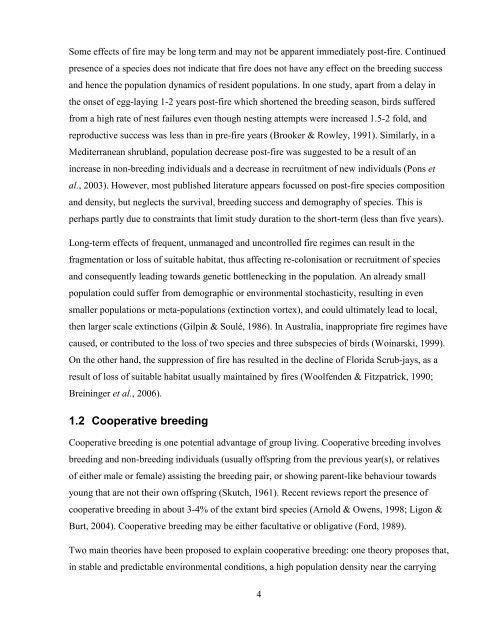Habitat use and population dynamics of the Azure-Winged Magpie ...
Habitat use and population dynamics of the Azure-Winged Magpie ...
Habitat use and population dynamics of the Azure-Winged Magpie ...
Create successful ePaper yourself
Turn your PDF publications into a flip-book with our unique Google optimized e-Paper software.
Some effects <strong>of</strong> fire may be long term <strong>and</strong> may not be apparent immediately post-fire. Continued<br />
presence <strong>of</strong> a species does not indicate that fire does not have any effect on <strong>the</strong> breeding success<br />
<strong>and</strong> hence <strong>the</strong> <strong>population</strong> <strong>dynamics</strong> <strong>of</strong> resident <strong>population</strong>s. In one study, apart from a delay in<br />
<strong>the</strong> onset <strong>of</strong> egg-laying 1-2 years post-fire which shortened <strong>the</strong> breeding season, birds suffered<br />
from a high rate <strong>of</strong> nest failures even though nesting attempts were increased 1.5-2 fold, <strong>and</strong><br />
reproductive success was less than in pre-fire years (Brooker & Rowley, 1991). Similarly, in a<br />
Mediterranean shrubl<strong>and</strong>, <strong>population</strong> decrease post-fire was suggested to be a result <strong>of</strong> an<br />
increase in non-breeding individuals <strong>and</strong> a decrease in recruitment <strong>of</strong> new individuals (Pons et<br />
al., 2003). However, most published literature appears focussed on post-fire species composition<br />
<strong>and</strong> density, but neglects <strong>the</strong> survival, breeding success <strong>and</strong> demography <strong>of</strong> species. This is<br />
perhaps partly due to constraints that limit study duration to <strong>the</strong> short-term (less than five years).<br />
Long-term effects <strong>of</strong> frequent, unmanaged <strong>and</strong> uncontrolled fire regimes can result in <strong>the</strong><br />
fragmentation or loss <strong>of</strong> suitable habitat, thus affecting re-colonisation or recruitment <strong>of</strong> species<br />
<strong>and</strong> consequently leading towards genetic bottlenecking in <strong>the</strong> <strong>population</strong>. An already small<br />
<strong>population</strong> could suffer from demographic or environmental stochasticity, resulting in even<br />
smaller <strong>population</strong>s or meta-<strong>population</strong>s (extinction vortex), <strong>and</strong> could ultimately lead to local,<br />
<strong>the</strong>n larger scale extinctions (Gilpin & Soulé, 1986). In Australia, inappropriate fire regimes have<br />
ca<strong>use</strong>d, or contributed to <strong>the</strong> loss <strong>of</strong> two species <strong>and</strong> three subspecies <strong>of</strong> birds (Woinarski, 1999).<br />
On <strong>the</strong> o<strong>the</strong>r h<strong>and</strong>, <strong>the</strong> suppression <strong>of</strong> fire has resulted in <strong>the</strong> decline <strong>of</strong> Florida Scrub-jays, as a<br />
result <strong>of</strong> loss <strong>of</strong> suitable habitat usually maintained by fires (Woolfenden & Fitzpatrick, 1990;<br />
Breininger et al., 2006).<br />
1.2 Cooperative breeding<br />
Cooperative breeding is one potential advantage <strong>of</strong> group living. Cooperative breeding involves<br />
breeding <strong>and</strong> non-breeding individuals (usually <strong>of</strong>fspring from <strong>the</strong> previous year(s), or relatives<br />
<strong>of</strong> ei<strong>the</strong>r male or female) assisting <strong>the</strong> breeding pair, or showing parent-like behaviour towards<br />
young that are not <strong>the</strong>ir own <strong>of</strong>fspring (Skutch, 1961). Recent reviews report <strong>the</strong> presence <strong>of</strong><br />
cooperative breeding in about 3-4% <strong>of</strong> <strong>the</strong> extant bird species (Arnold & Owens, 1998; Ligon &<br />
Burt, 2004). Cooperative breeding may be ei<strong>the</strong>r facultative or obligative (Ford, 1989).<br />
Two main <strong>the</strong>ories have been proposed to explain cooperative breeding: one <strong>the</strong>ory proposes that,<br />
in stable <strong>and</strong> predictable environmental conditions, a high <strong>population</strong> density near <strong>the</strong> carrying<br />
4

















